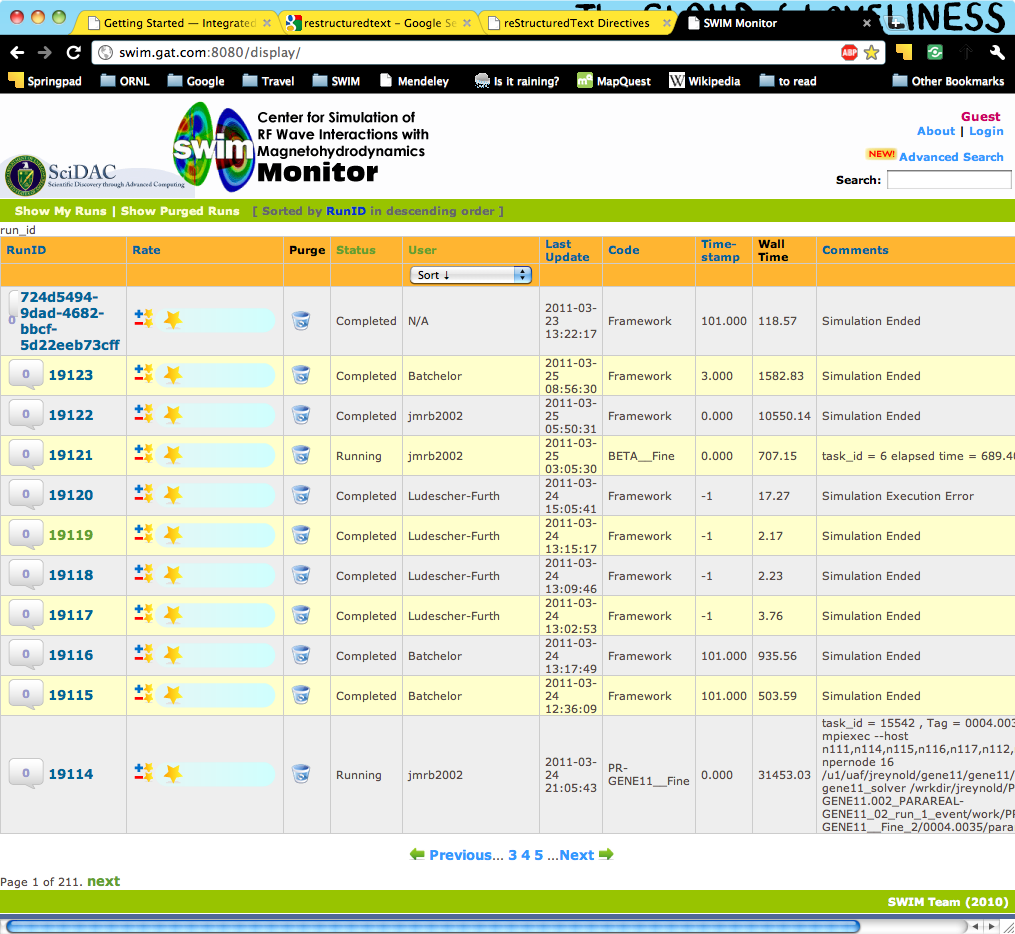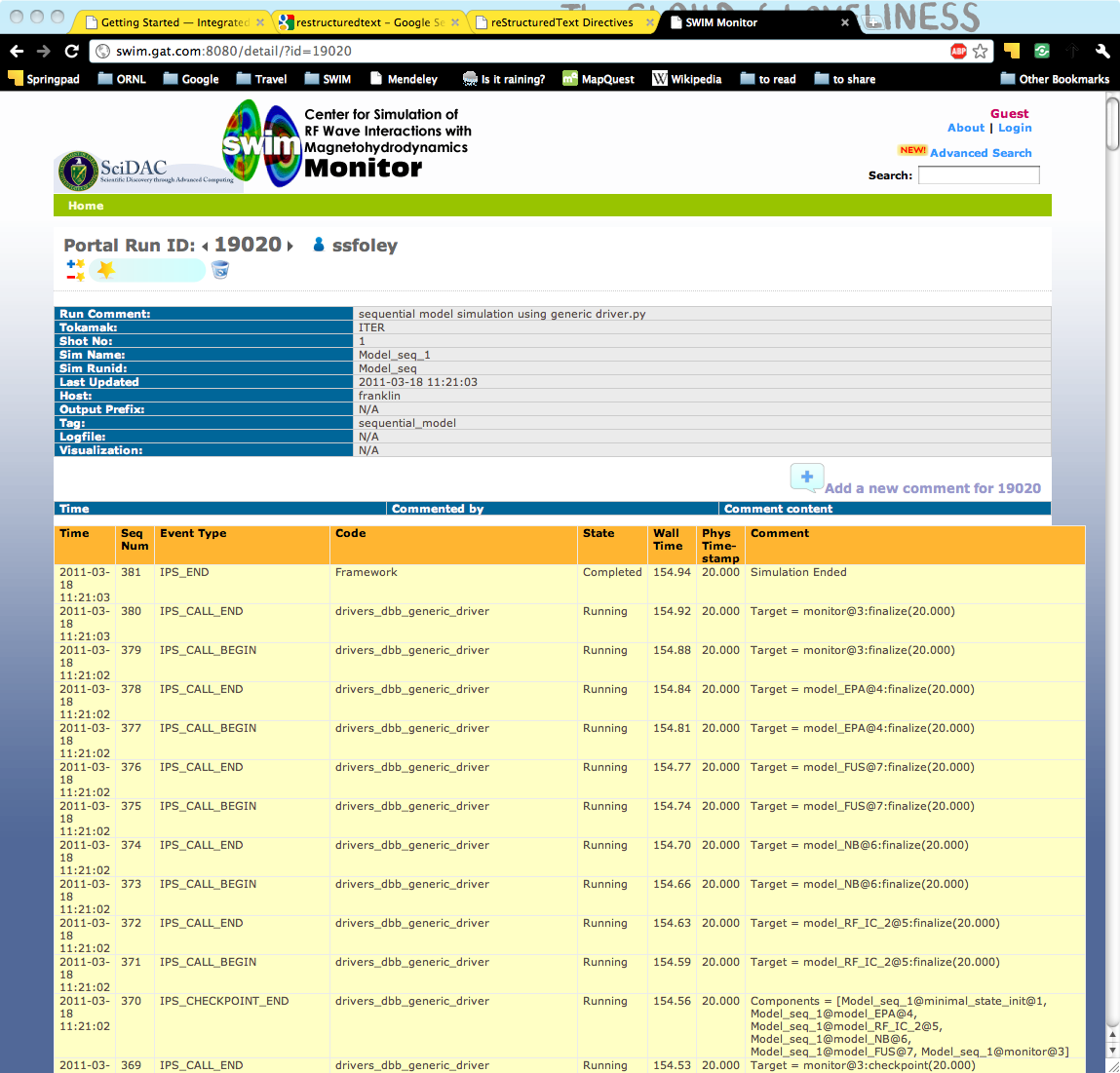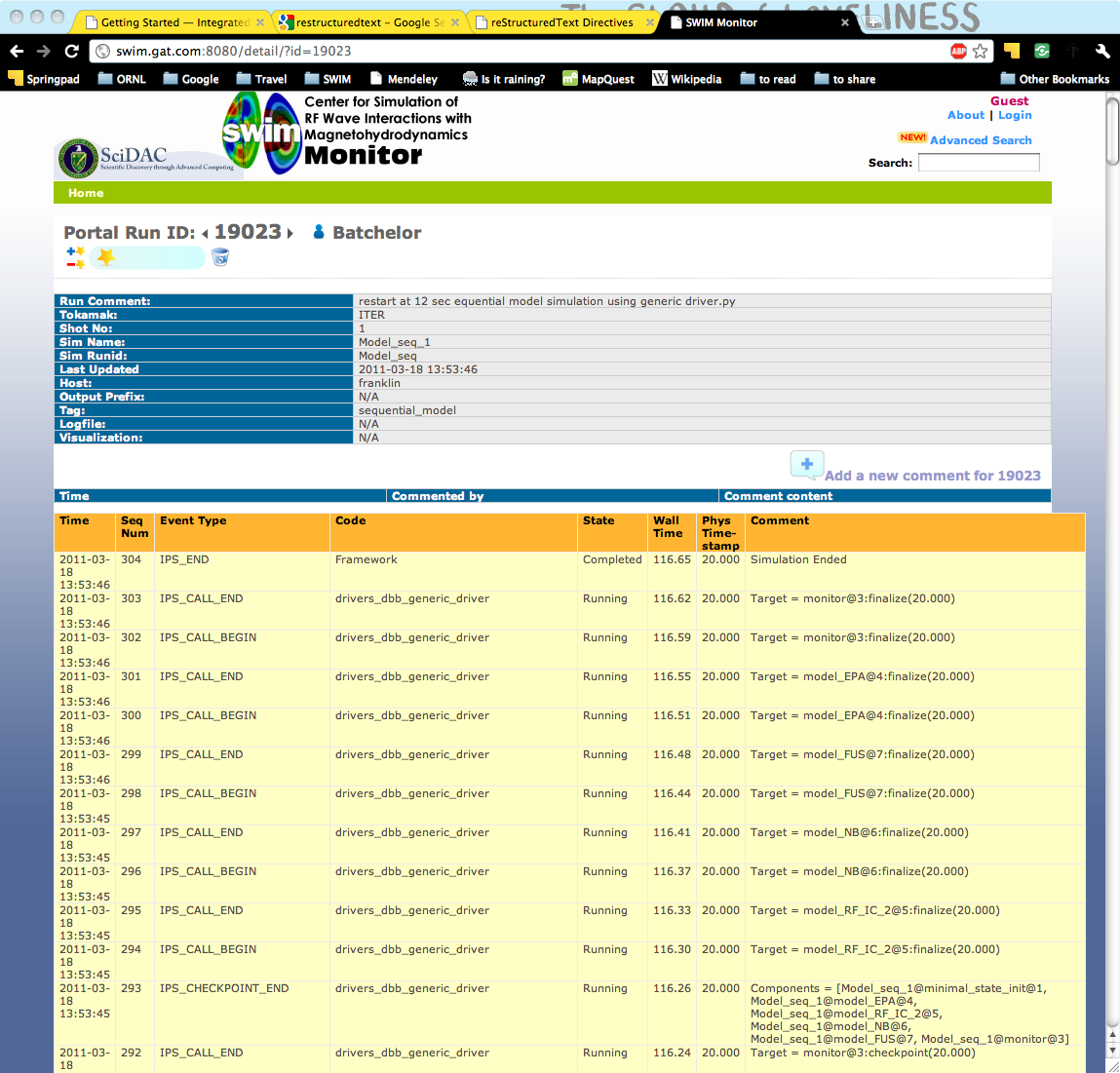Getting Started with the Simyan Branch¶
This document will guide you through the process of running an IPS simulation and describe the overall structure of the IPS. It is designed to help you build and run your first IPS simulation. It will serve as a tutorial on how to get, build, and run your first IPS simulation, but not serve as a general reference for constructing and running IPS simulations. See the Basic User Guides for a handy reference on running and constructing simulations in general, and for more in-depth explanations of how and why the IPS works.
Dependencies¶
IPS Proper
The valtools repo will build the entire dependency tree for IPS, related repos, and the dependencies using Bilder. See the main documentation for the dependencies.
For more inf
Portal
The portal is a web interface for monitoring IPS runs and requires only a connection to the internet and a web browser. Advanced features on the portal require an OpenID account backed by ORNL’s XCAMS. Information on getting an XCAMS backed OpenID can be found on the SWIM_ website. There are also visualization utilities that can be accessed that require Elvis or PCMF (see below).
Other Utilities¶
- PCMF
This utility generates plots from monitor component files for visual analysis of runs. It can be run locally on your machine and generates plots like this one of the thermal profiles of an ITER run:
Requires: Matplotlib (which requires Numpy/Scipy)

- Resource Usage Simulator (RUS)
This is a utility for simulation the execution of tasks in the IPS for research purposes.
Requires: Matplotlib (which requires Numpy/Scipy)
- Documentation
The documentation you are reading now was created by a Python-based tool called Sphinx.
*Plus* anything that the components or underlying codes that you are using need (e.g., MPI, math libraries, compilers). For the example in this tutorial, all packages that are needed are already available on the target machines and the shell configuration script sets up your environment to use them.
| [1] | For Python 2.5, an external package - processing - is used by the framework, however it was incorporated into Python 2.6 and higher as the multiprocessing module. Each package allows Python to spawn, manage and communicate between multiple processes, a key capability that allows the IPS to achieve multiple levels of parallelism. |
Building and Setting up Your Environment Using Bilder¶
The IPS code is currently located in the SWIM project’s Subversion (SVN) repository. In this documentation, we will discuss using it from the Tech-X repos to discuss the new repos. IPS is currently part of the Simyan repo which is svn:external’d from the ValtoolsAll repo. The valtoolsall repo is for enabling a simplified environment for python packages. To check out the valtoolsall repo:
svn co https://ice.txcorp.com/svnrepos/code/valtoolsall/trunk valtoolsall
Using bilder and the valtoolsall project:
cd valtoolsall
./mkvaltoolsall-default.sh -n
After running bilder, the output file will tell you where things are installed (<INSTALL_DIR>) and where things are built (<BUILD_DIR>). To configure your environment, you need to source the configuration files. For bash users:
source <INSTALL_DIR>/valtoolsall.sh
For tcsh users:
source <INSTALL_DIR>/valtoolsall.csh
To test the builds:
cd <BUILD_DIR>/simyan/ser
make test
This will run all of the tests. The documentation, assuming the -D flag was passed to bilder, will be in the webdocs build directory (<BUILD_DIR>/simyan/webdocs).
Building and Setting up Your Environment direct from repo¶
Assuming you have the dependencies installed, you can jst check out the repo and configure directly. To obtain the rep:
https://ice.txcorp.com/svnrepos/code/simyan/trunk ips
- Assuming your dependencies are installed in /usr/local or /contrib, you can configure the file in a build subdirectory:
mkdir build cd build cmake
-DCMAKE_INSTALL_PREFIX:PATH=$INSTALL_DIR/simyan -DCMAKE_BUILD_TYPE:STRING=RELEASE -DCMAKE_VERBOSE_MAKEFILE:BOOL=TRUE -DCMAKE_INSTALL_ALWAYS:BOOL=TRUE -DSUPRA_SEARCH_PATH=’/usr/local;/contrb’ -DENABLE_WEBDOCS:BOOL=ON -DMPIRUN:STRING=aprun -DNODE_DETECTION:STRING=manual -DCORES_PER_NODE:INTEGER=4 -DSOCKETS_PER_NODE:INTEGER=2 -DNODE_ALLOCATION_MODE:SHARED=shared $PWD/..
# After configuring, to build IPS, the documentation, and run the tests respectively:
make
make docs
make test
make install
The documentation may be found at docs/html/index.html. The tests are located in the tests subdirectory.
Now you are ready to set up your configuration files, and run simulations.
Running Your First IPS Simulations¶
This section will take you step-by-step through running a “hello world” example and a “model physics” example. These examples contain all of the configuration, batch script, component, executables and input files needed to run them. To run IPS simulations in general, these will need to be borrowed, modified or created. See the Basic User Guides for more information.
Before getting started, you will want to make sure you have a copy of the ips checked out and built on either Franklin or Stix.
On Franklin you will want to work in your $SCRATCH directory and move to having the output from more important runs placed in the /project/projectdirs/m876/* directory.
On Stix you will want to work in a directory within /p/swim1/ that you own. You can keep important runs there or in /p/swim1/data/.
Hello World Example¶
This example simply uses the IPS to print “Hello World,” using a single driver component and worker component. The driver component (hello_driver.py) invokes the worker component (hello_worker.py) that then prints a message. The implementations of these components reside in ips/components/drivers/hello/, if you would like to examine them. In this example, the call() and launch_task() interfaces are demonstrated. In this tutorial, we are focusing on running simulations and will cover the internals of components and constructing simulation scenarios in the various User Guides (see Index).
Copy the following files to your working directory:
Configuration file:
/ips/doc/examples/hello_world.config
Batch script:
/ips/doc/examples/<machine>/sample_batchscript.<machine>
Edit the configuration file:
Set the location of your web-enabled directory for the portal to watch and for you to access your data via the portal. If you do not have a web-enabled directory, you will have to create one using the following convention: on Franklin: /project/projectdirs/m876/www/<username>; on Stix: /p/swim/w3_html/<username>.
Franklin:
USER_W3_DIR = /project/projectdirs/m876/www/<username> USER_W3_BASEURL = http://portal.nersc.gov/project/m876/<username>
Stix:
USER_W3_DIR = /p/swim/w3_html/<username> USER_W3_BASEURL = http://w2.pppl.gov/swim/<username>
This step allows the framework to talk to the portal, and for the portal to access the data generated by this run.
Edit the IPS_ROOT to be the absolute path to the IPS checkout that you built. This tells the framework where the IPS scripts are:
IPS_ROOT = /path/to/ips
Edit the SIM_ROOT to be the absolute path to the output tree that will be generated by this simulation. Within that tree, there will be work directories for each of the components to execute for each time step, along with other logging files. For this example you will likely want to place the SIM_ROOT as the directory where you are launching your simulations from, and name it using the SIM_NAME:
SIM_ROOT = /current/path/${SIM_NAME}Edit the USER entry that is used by the portal, identifying you as the owner of the run:
USER = <username>
Edit the batch script such that IPS_ROOT is set to the location of your IPS checkout:
IPS_ROOT=/path/to/ips
Launch batch script:
head_node: ~ > qsub hello_batchscript.<machine>
Once your job is running, you can monitor is on the portal.

When the simulation has finished, the output file should contain:
Starting IPS
Created <class 'hello_driver.HelloDriver'>
Created <class 'hello_worker.HelloWorker'>
HelloDriver: beginning step call
Hello from HelloWorker
HelloDriver: finished worker call
Model Physics Example¶
This simulation is intended to look almost like a real simulation, short of requiring actual physics codes and input data. Instead typical simulation-like data is generated from simple analytic (physics-less) models for most of the plasma state quantities that are followed by the monitor component. This “model” simulation includes time stepping, time varying scalars and profiles, and checkpoint/restart.
The following components are used in this simulation:
- minimal_state_init.py : simulation initialization for this model case
- generic_driver.py : general driver for many different simulations
- model_epa_ps_file_init.py : model equilibrium and profile advance component that feeds back data from a file in lieu of computation
- model_RF_IC_2_mcmd.py : model ion cyclotron heating
- model_NB_2_mcmd.py : model neutral beam heating
- model_FUS_2_mcmd.py : model fusion heating and reaction products
- monitor_comp.py : real monitor component used by many simulations that helps with processing of data and visualizations that are produced after a run
First, we will run the simulation from time 0 to 20 with checkpointing turned on, and then restart it from a checkpoint taken at time 12.
Copy the following files to your working directory:
Configuration files:
/ips/doc/examples/seq_model_sim.config /ips/doc/examples/restart_12_sec.config
Batch scripts:
/ips/doc/examples/model_sim_bs.<machine> /ips/doc/examples/restart_bs.<machine>
Edit the configuration files (you will need to do this in BOTH files, unless otherwise noted):
Set the location of your web-enabled directory for the portal to watch and for you to access your data via the portal.
Franklin:
USER_W3_DIR = /project/projectdirs/m876/www/<username> USER_W3_BASEURL = http://portal.nersc.gov/project/m876/<username>
Stix:
USER_W3_DIR = /p/swim/w3_html/<username> USER_W3_BASEURL = http://w2.pppl.gov/swim/<username>
This step allows the framework to talk to the portal, and for the portal to access the data generated by this run.
Edit the IPS_ROOT to be the absolute path to the IPS checkout that you built. This tells the framework where the IPS scripts are:
IPS_ROOT = /path/to/ips
Edit the SIM_ROOT to be the absolute path to the output tree that will be generated by this simulation. Within that tree, there will be work directories for each of the components to execute for each time step, along with other logging files. For this example you will likely want to place the SIM_ROOT as the directory where you are launching your simulations from, and name it using the SIM_NAME:
SIM_ROOT = /current/path/${SIM_NAME}Edit the RESTART_ROOT in restart_12_sec.config to be the SIM_ROOT of seq_model_sim.config.
Edit the USER entry that is used by the portal, identifying you as the owner of the run:
USER = <username>
Edit the batch script such that IPS_ROOT is set to the location of your IPS checkout:
IPS_ROOT=/path/to/ips
Launch batch script for the original simulation:
head_node: ~ > qsub model_sim_bs.<machine>
Once your job is running, you can monitor is on the portal and it should look like this:

When the simulation has finished, you can run the restart version to restart the simulation from time 12:
head_node: ~ > qsub restart_bs.<machine>
The job on the portal should look like this when it is done:
